H.M. Motor Launch 145
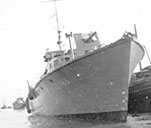
C.O.’s report
C.O. ML 145
26.9.43
S.O. Unit W (C.O. ML 150)
Sir,
I have the honour to submit report of my movements during action against 3 E-boats on night 24-25 Sept 1943. Upon receipt of ‘Fleeting’ signal at 0112 I took station on the Port quarter of ML150 in accordance with pre-arranged tactics, expecting the enemy to be sighted coming from the coast. Speed 15 knots course 180.
At 0120 sighted two phosphorescent tracks close together & parallel line on starboard bow. At the same moment look-outs reported 3 bow-waves approaching from starboard, proceeding eastwardly. The first two tracks were taken to be torpedoes, fired by the leading E-boat who appeared to alter course slightly to the southward, away from the tracks of his torpedoes; the torpedoes passed ahead of unit (?). His speed was too great to make a chase feasible, but his parting was hastened by 3 pounder fire. This fire was returned by the enemy but was high and ineffectual. I had seen ML150 go into action with the second in line, but could not assess what damage had been inflicted on the enemy. On seeing this E-boat emerging from 150’s possessive embrace at a speed of 8-10 knots in a direction roughly SE, I tried to emulate S.O.’s tactics & went hard to starboard, at 20 knots, hoping to ram before he had recovered. I could not bring ship round quickly enough, however, and passed about 15 yards ahead of enemy, who was making smoke. My gunners needed no urging to seize such a magnificent opportunity, and the two Oerlikons and starboard twin Vickers just didn’t take their fingers off. The expected heavy retaliatory fire did not materialise, except for spasmodic bursts of white tracer fired wildly & too high. It seemed that his forward gun must have been put out of action. The line of fire was getting near 150 who had her fighting lights on, so I stopped firing. I steadied the ship’s swing, with the intention of closing this boat again, but as I came clear of 150 I saw the third E-boat in the line had made a violent alteration of course to port, and was running in a North-Westerly direction, passing fairly close to 150 who opened up on her. I reduced speed & kept all guns bearing on this E-boat, who was now receiving concentrated fire from both boats. The Oerlikons fired two magazines each at him as he retired to the Northward & the 3 pounder 8 rounds, 3 or 4 of which appeared to hit.
It was not considered practicable to chase him in view of our inferior speed, particularly as 150 seemed to be in difficulties, so at 0126 I steered for the E-boat which we had previously tried to ram. He was trying to retire to the South East under cover of smoke at about half speed. I fired a parachute flare from the Holman Projector, which lit him up very clearly, increased to maximum revs and tried to gain bearing so as to ram from abeam or on his bow. All guns were brought to bear and he took a lot of punishment, both from 3 pounder, Oerlikons and Vickers. It now seemed that if the ramming was successful there was a good chance of boarding, so the boarding party was closed up on the forecastle with Lanchester automatics and bayonets, under the 1st Lieut., and a signal to this effect was made. His firing was now rather more pronounced but the majority was still high. When I was in a favourable position at about 200 yards range I altered course to ram, the 3 pounder firing well on the run-in. When he saw me coming, he altered course towards me, apparently to narrow the angle, and so (?) I rammed head on at a relative speed of approach of 30 knots, a supremely exhilarating experience. I actually hit him slightly on my starboard bow, climbed up on him (carrying away my Asdic dome in the process) and then carri?? (careered?) down his starboard side. His alteration of course at the last minute had foiled my hope of ‘sitting’ on him and thus getting my boarding party away, but in the few seconds that we took to scrape past him both Oerlikons, starboard Vickers and the Lanchesters of the boarding party opened up on him. I tried to help the party by lobbing a hand grenade on to him but in the utter confusion of smoke, gunfire & fires aboard the E-boat, the result was difficult to appreciate. I have no knowledge of German, but in the few seconds it took to scrape past him, I gathered that the German voices coming from the bridge were not shrieking terms of endearment.
This combination of ramming and gun fire was the final coup and several fires were seen. My gunnery ratings reported seeing little sign of life on the upper deck. Unfortunately I had been holed in my bows beneath the water line, so was making a lot of water in my fore-peak & mess deck. Luckily the water-tight bulkhead held, although splintered and leaking in the W.T. cabin, but the weight of water forced the bows down & the rudders almost clear of the water. My steering was therefore useless, and the water was rising in the W/T cabin to within an inch of the generator. By shoring up the cracked bulkhead in the W/T cabin, and using main and auxiliary pumps, this was checked & the W/T kept in action. Telegraphist J. Flavell carried out his duty exceptionally well under most difficult conditions & continued operating for nigh on 12 hours, for part of which he was knee deep in water.
Meanwhile the enemy was stopped about ½ mile away & several fires & much smoke were visible. I tried to swing the boat around, using engines to pivot but the wind made this too laborious so I went towards the E-boat stern first. He was firing white tracer in the air, and I took this to mean he was finished so stopped firing. My speed of approach was infuriatingly only five knots, and I had my fighting lights on. When I was within 800 yards, one of his guns opened upon me with a short fairly accurate burst, passing close overhead. One of the crew remarked that it was not --- cricket! And I told the after Oerlikon to give him another magazine full. This was most effective. Men appeared to be jumping overboard, and several lights and flares were bobbing about in the vicinity. By the time I got on the scene, the E-boat had sunk. The task of picking up survivors was laborious owing to the heavy sea & lack of manoeuvrability. After an hour we had two officers and 11 ratings aboard some of whom were wounded. The officers were kept separate – one locked in the Ward Room Bathroom, the other in the Pantry. 4 Ratings were put in the Tiller Flat, 6 in the Ward Room & Ward Room Flat & one, rather badly injured in the back, was kept in the Wheelhouse, all under armed guard.
As my pumps had made some impression on the water, I was able to make 4 knots ahead & rejoined ML150 at approx. 0300.
This was the first time the ship’s Company has been in action and their discipline, efficiency and will to fight were inspiring. The good work of the number ones’ at each gun is particularly commendable – D. Rowley, AB, Coleman AB and Town AB.
I append herewith information obtained from the German Officers, one of whom stated he was off S96 & the other S95.
Oberleutnant ? (2 rings) the Commanding Officer. Age about 24 or 25. Unmarried. Was unwilling to talk at first, but after diplomatically bandaging a severe wound on his forearm & an occasional cigarette, he was fairly amenable to interrogation. His English was quite good. Joined German Navy 1937. Was in cruisers before the war & has been in destroyers most of the war, in Norway and France. Was sunk at Narvik twice, when our people went in there. Is fairly new to E-boats. Said he had carried torpedoes, no mines (?) but it was not he who fired torpedoes at us. Said there were three in group, of which he was number 2. They came from their base at Rotterdam together & split up into units of 3 subsequently (would not say where). Said they lived in houses ashore at Rotterdam, not on their boats. At some bases they live aboard. Said his complement was 2 officers & 25 ratings. Spoke highly of his machine man, and said that when the boat was sinking he had to go down to the ‘Machines’ himself & take him out, as he didn’t want to leave. The machine room was full of smoke and on fire. He himself did not sight us until we were about 200 metres away, indicating that he had no radar or warning device. Lived in Berlin, where he said he had been 2 days ago on leave. Said outskirts were damaged, but not the centre very much (???) Had been in Hamburg recently and that was “no more there”. Had a healthy respect for the 3 pounder. Said they had no gun as heavy. They had no Oerlikon, but had some 20mm guns.
Leutnant? (one ring) Not very communicative. English not very good. Age about 26 married. Home in Wilhelmshaven. Thought they had been attacked by 4 gunboats & was under the impression he was prisoner aboard a gunboat. This he said was reason the other E-boats had not come to their help and picked up survivors – to his disgust. Said the other boats knew his boat was in difficulties (possibly the y-material can confirm) & they had expected assistance.
Tailpiece – One of the Ratings on coming aboard: “Where go – Lowestoft?”
It is likely that the following interview was given to the author of The Battle of the Narrow Seas, Lt Cdr Peter Scott, as he quotes many of the same words in the book, in which Lt J O Thomas is acknowledged and thanked for having written about this episode.
J = Lt J.O. Thomas. S = Lt R.F. Seddon. F = interviewer (Peter Scott?)
F: Can you tell me a little but about the background to this very successful operation of yours?
T: Well, we’d been doing this hunting for E-boats for a very long time, and never caught up with anything of interest whatsoever. It was really very monotonous. Other people have had quite a lot of fun, but the M.L’s had been rather left out of the picture. On this particular night Ron and I sailed …
F: Ron’s Lieut. Seddon is he?
T: Yes. Well, on this particular night, the weather didn’t seem particularly promising. But we had hopes of meeting up with some fun. We reached our patrol position and settled down to the usual night of heavy rolling and monotonous waiting. It got very black, and I was amusing myself with working out minor navigation problems.
S: Was that the lurid poem you showed us afterwards?
T: We’ll skip that. Anyway, we suddenly received a signal directing us to an intercepting position. We cracked off south into quite a heavy sea, with our gun crews closed up at action stations and with Ron following close astern. We hadn’t been under way very long when I suddenly sighted something on my starboard bow, which looked suspiciously like E-boats. They were travelling at a very high speed, and I just had time to challenge them when their leader flashed across my bows and I pressed the “open fire” gong. We got in a short burst at the second ship of the line, and by that time I could see that he was making an ideal approach to be rammed.
F: Must have shaken you a bit. How did you feel?
T: My immediate reaction – and there was only time for reaction, not for reasoned thinking – was: “This is the moment I’ve been waiting for for a very long time.” We’d been putting a lot of hard training, and my actions from then on were almost instinctive. Something like “This is it” flashed through my mind, and I just made straight for him. We hit him with a terrific crash just forrard of his bridge, and there was an awful rending crash and bits of metal and wood flew around my head and the coxswain’s – who was standing on the wheel beside me. The E-boat bounced clear with a lot of smoke coming from it, and my port gunner got in a crack at him. He vanished ion a cloud of smoke, and I stopped my engines because my bows were then not all that they should be. Whilst I was lying stopped, Ron came roaring up on my port side with his guns blazing and took over where I’d left off.
F: Now, Lieutenant Seddon, what was happening to you all this time?
S: As the first E-boat tore across in front of us, I opened fire with the only gun that would bear. Then as I saw the second E-boat breaking away from Jimmy’s possessive embrace, I thought I might be able to ram him again before he knew what it was all about. I was now going full speed, and put my wheel hard over but, unfortunately, passed about fifteen yards ahead of him. So much was happening at the time, and there were so many things occupying my mind, that it was magnificent to see the gunners opening fire on their own initiative: they put their fingers on the triggers and just didn’t take them off.
F: But weren’t you afraid of hitting each other at such close range?
S: Yes, all through the action that was one of our main worries, and as I passed clear of the E-boat, I had to cease fire as Jimmy was now in the line of my guns – it’s not very good policy to blow up your senior officer. After receiving this concentrated fire from both boats, the E-boat went on much slower, with smoke still pouring from him, and I was about to bring my ship round to ram him when I saw a third E-boat closing Jimmy. All my guns were brought to bear on this one, and we scored many hits. You opened fire at the same time didn’t you, Jimmy?
T: Yes, as were lying stopped this E-boat came round my stern and up my starboard side and I was able to open fire on him and give him a good burst before he vanished into the darkness under a smoke screen.
S: I think he took a lot of punishment in those few moments?
T: Yes, I reckon we knocked eight bells out of him.
F: And what was happening to E-boat Number Two?
S: He was still staggering on making smoke, and as his speed was reduced, I thought my best method of attach was to ram. I approached him with all my guns firing from my port side, and when I was in a favourable position, altered course straight for him. I thought that if I could sit on him there would be a good chance of getting my boarding party away, so these were told to stand by. When the E-boat saw that I intended to ram, he altered course towards me so as to try to narrow the angle. I had rung down for maximum speed, and when I was about thirty yards away I could see my only chance was to ram him head on.
F: And he was firing at you all the time I suppose?
S: Yes, but they didn’t do much damage. My coxswain kept a very good course, but at the last second the E-boat altered a bit and we rammed him slightly on his bow. We seemed to climb on top of him, then heeled over as we fell clear and scraped right down his starboard side. Our speed was too great for the boarding party to get away, but all the guns opened fire at literally point blank range. As we rubbed along we could see several fires, but little sign of activity on his upper deck. While I was trying to bring my boat wound to close him again, he started firing tracer into the air, which I thought meant he was packing up. But when I stopped siring, one of his guns opened up at me again and one of my ratings said he didn’t think that was Blank Blank cricket. So I told one of my gunners to let him have another magazine full. He opened fire and this was apparently too much for the E-boat, and the crew started jumping into the water. Almost immediately afterwards there were a few minor explosions and the E-boat went down in a shower of sparks.
F: And then you picked up survivors, I suppose?
T: Yes, we spent the next hour picking up survivors. We got 16 all told but Ron got most of them: he got thirteen; I got three. A few hours later, when I went down to the wardroom to see how they were getting on, I found that my armed guard had turned them all into my blankets, and was treating them to a recital of my records on my gramophone.
168 THE BATTLE OF THE NARROW SEAS
On the evening of 24th September, I943, six E boats of the 4th Flotilla, under the command of Korvettenkapitän Werner Lützow, set out from Rotterdam on a minelaying and torpedo sortie against the British east-coast convoy route. Outside the harbour two further flotillas joined company, and the combined force proceeded westward1.
At about the same time a number of Coastal Force craft, as well as destroyers and trawlers, were taking up their anti E boat dispositions on the Z lines - the standing patrol positions which protected our shipping lane. Amongst them were two “B" Class M.Ls. - 150 commanded by Lt. J. 0. Thomas, R.N.V.R., and 145 commanded by Lt. R. F. Seddon, R.N.V.R. For nearly two years these M.Ls. had been carrying out monotonous anti E boat patrols, and had listened with envy to the tales of their more fortunate comrades in the gunboats and torpedo boats, who appeared to be having all the fun. "All we seemed to get was lots of sea time and more than our share of bad weather." But to-night their triumph was at hand. Their luck was about to turn. Even to-night, however, the wind was beginning to freshen, with promise of dirty weather before dawn.
The freshening wind was a source of anxiety to the E boats, too, as they approached our coast. At one time it seemed likely that they would have to abandon the operation, but they decided to carry on, and finally divided up into groups in order to lay their mines.
At about 1 a.m. one group, consisting of three E boats, came suddenly upon a patrol of two trawlers. Their presence was almost immediately detected by the trawlers, one of which, as she turned towards, saw a torpedo passing down her port side, no more than 6 feet clear. Another torpedo was on its way, however, and this time the aim was true. H.M. Trawler Franc Tireur was hit amidships and sank within a few seconds. The first torpedo had been fired by the E boat S.88, in which the Senior Officer, Korvettenkapitän (Lieutenant Commander) Lützow was himself embarked. The second and successful attack had been made by S.96 commanded by Leutnant-zur-see Wilhelm Sander. Sander was new to E boats, but he had with him a more experienced officer, Oberleutnant Wilhelm Ritter Von Georg. the Commanding Officer of an E boat that was refitting at the time. S.99, the third boat of the group, did not get into position in time, and did not fire torpedoes at all.
When the E boats had disengaged they stopped to discuss the battle.
"Who hit the trawler?" shouted Lützow.
"It was us, sir," replied von Georg.
"Nice work-congratulations! We'll keep together now."
The three boats formed up in line ahead and retired to the eastward at 30 knots.
At the same time M.Ls. 150 and 145 were steering south from their patrol line at full speed to cut off the enemy's retreat. It was a very dark night, but at 1.20a.m. the M.Ls. sighted phosphorescent bow waves 500 yards away on the starboard bow. Thomas knew at once what he was going to do. His maximum speed was so low that the E boats would outrange his guns in a few seconds. They might be damaged during that time, but they were not likely to be destroyed. The only way to sink an E boat was to ram it, so Thomas held his course for S.96, the second E boat in the line. He writes:
"My immediate reaction-and there was only time for reaction, not for reasoned thinking -was 'This is the moment I've been waiting for a very long time.' We'd been putting in a lot of hard training, and my actions from then on were almost instinctive. Something like 'This is it' flashed through my mind, and I just made straight for him. We hit him with a terrific crash just for'ard of his bridge, and there was an awful rending crunch. It threw my crew flat on the deck, and bits of wood and metal flew round our heads on the bridge.
1 The movements of the enemy described in this chapter are reconstructed from statements made by German prisoners of war.
169 THE BATTLE OF THE NARROW SEAS
The E boat bounced clear with a lot of smoke coming from it, and my port gunner got in a crack at him. He vanished in a cloud of smoke, and I stopped my engines because my bows by then were not all that they should have been."
When two fast boats are approaching each other at right angles, split seconds make the difference between ramming and being rammed. Thomas had judged it well but, in spite of that at this stage the M.L. had received greater damage than the E boat. Her bows had been carried away to the forward side of the wheelhouse, and she was in some danger of sinking. But the E boat's speed had been reduced. As it rebounded clear of the M.L. and went off slowly into the darkness, S.99 overtook it and dashed on after the leader, being subjected to a flood of abuse from everyone on S.96's upper deck for leaving them in the lurch.
Meanwhile M.L. 145 had plunged into the engagement, firing with all guns that would bear. The sea was too rough for accurate gunnery, however, and Seddon had also decided that the only way to make certain of the E boat's destruction was to ram it. "When I saw him breaking away from Jimmy Thomas's possessive embrace, I thought I might be able to ram him again before he knew what it was all about." At the first attempt, Seddon missed narrowly, but, firing all the while, he gained bearing for a second attempt. The E boat was returning the fire fiercely, but she was too badly damaged to escape. It was some twelve minutes after the initial contact that M.L. 145 turned in again to ram. The enemy seemed to anticipate the manoeuvre and also altered course - towards the M.L. The two boats met almost head on with terrific impact at a relative speed of approach of more than 25 knots.
“We seemed to climb on top of him," writes Seddon, "then heeled over to port as we slid off again and scraped right down his starboard side. Our speed was too great for the boarding party to get away, but all the guns opened fire at a range of approximately 1 yard. As we rubbed alongside we could see several fires, but little sign of activity on his upper deck." The M.L. was badly holed forward and making water rapidly in the forepeak and mess-deck, but the watertight door and the bulkhead were holding, and she was still manoeuvrable with difficulty.
At 0140," continues Seddon in his report, "the enemy was stopped about half a mile away and burning fiercely. I tried to close him, steering by engines, but the wind and the heavy sea made this extremely difficult, and I had to approach stem first."
S.96 had been trying feverishly to make radio contact with her S.O., to inform him that the two British boats were damaged and to summon aid, but it was of no avail. Korvettenkapitän Lützow had turned back to the rescue, but it appears that his look-out reported the presence of four British boats and. against such odds the attempt was abandoned.
Oberleutnant Von Georg finally seized one of the machine guns on the bridge and fired a burst of tracer vertically into the air as a last effort to obtain assistance. Seddon, wrongly interpreting this distress signal as an indication of surrender, sounded the cease fire and began to close in, but von Georg, who by now had taken command of the situation, was still determined to fight, and a burst of fire greeted the M.L. as she closed. "Not quite cricket," was how one of Seddon's crew described it afterwards, though, in fairness, it must be said that there was no reason whatever for supposing that a burst of vertical tracer was the equivalent of a white flag. -Von Georg called for hand grenades and was bitterly disappointed when they could not be found. In his own boat he would have known where to look for them but in S.96 everything was stowed differently. The E boat was heavily on fire aft, and for a short period complete confusion reigned. Von Georg left the bridge and tried to bring one of the forward guns into action, but they were all jammed and by this time most of the crew were casualties. Turning to Sander, he shouted, "We must scuttle."
The order was given to abandon ship, and the scuttling charges were fired in the engine-
169 THE BATTLE OF THE NARROW SEAS
room. Then the crew jumped overboard and were kept as far as possible in one group by von Georg. "Shortly afterwards," says Seddon, "there were some minor explosions and the E boat disappeared amid a shower of sparks."
Meanwhile M.L. 150 was in a bad way, and indeed Thomas's chief concern was the safety of his ship in the rising sea. A quarter of the ship had gone altogether, but the bulkhead was shored up and the pumps were controlling the water in the galley flat. The rudders had jammed hard a-starboard, so that under way the ship could only make circles. Finally, however, Thomas found he could steer west by engines alone, stern first at about 3 knots. “By then,” he continues, “we could hear the E boat survivors shouting in the water. It took us at least an hour to pick them up, because of the sea that was running. I was able to manoeuvre close to a raft, and then to drift down on to it. There were three ratings on the raft, one of whom was laid out, having swallowed a lot of oil. When the raft was fairly near me the two Germans who were up and doing jumped into the water and swam towards us, leaving the third man to his fate: but the yells of my infuriated crew sent them back for him, and eventually the three were hauled inboard. I could not leave the bridge, but ordered an armed guard to take them down into the wardroom for medical attention. A few hours later, when I was able to visit them, I found the Germans turned in, in my blankets, with the armed guard playing them my records on my gramophone.
M.L. 145 rescued thirteen Germans, including two officers. One of these attracted attention to himself in the water by blowing steadily on a referee's whistle. When the search-light beam found him he was seen still to be wearing his cap at a very rakish angle, and it appears that he kept it so until he was landed at our base.
Soon after 6 a.m. two M.G.Bs. arrived on the scene. M.L. 145 proceeded homeward under her own power, but M.L. 150 was taken in tow stern first and finally reached harbour at 2p.m. On the way, Thomas describes “a very tricky piece of seamanship carried out by the gunboat that was towing us. We had had to extinguish the galley stove because of the petrol which had leaked into the bilges. In that sea it was impossible for him to come along-side, and we were all badly in need of a hot drink. So tea, gallons of it, was floated down to us in 'safari jars' lashed to a small Carley float. The float was secured to a grass line and by slight alterations of course they were able to manoeuvre it alongside us so that we could haul it inboard with boat hooks. Never has tea tasted better."
POSTSCRIPT
German Telegraph Service (DNB European) 11.30 a.m., 26th September, 1943. Berlin (International Information Bureau. Midday): “Yesterday morning German E boats attacked British patrol vessels with torpedoes off the English coast and sank one of the British vessels. Visibility deteriorated. British M.T.Bs came to the aid of the hard-pressed British patrol vessels, but were unable to make a successful attack. There was a heavy fog, and a German E boat tore off the bows of a British M.T.B. near the bridge so that the vessel sank at once. The German E boat also sustained considerable damage, so that her crew was no longer able to keep her afloat and scuttled her.”
THE BATTLE OF THE NARR0W SEAS by Lt. Cdr. Peter Scott
Published 1945 reprinted 1946. London: Country Life Limited, 3-10 Tavistock Street, Covent Garden, WC2



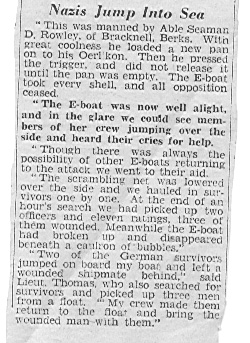
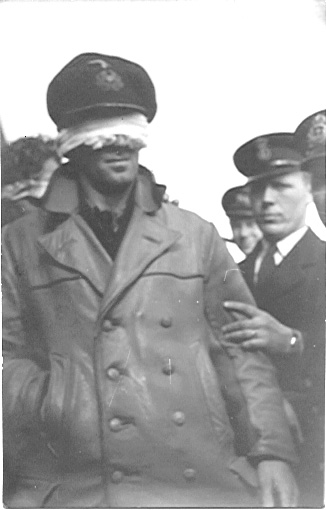
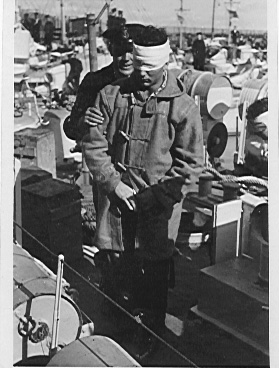
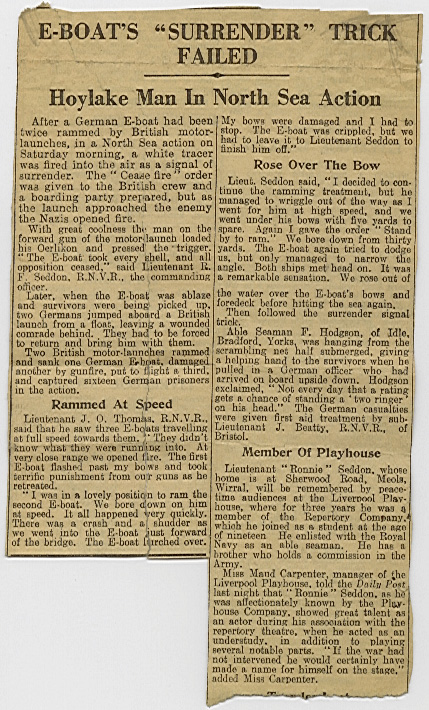
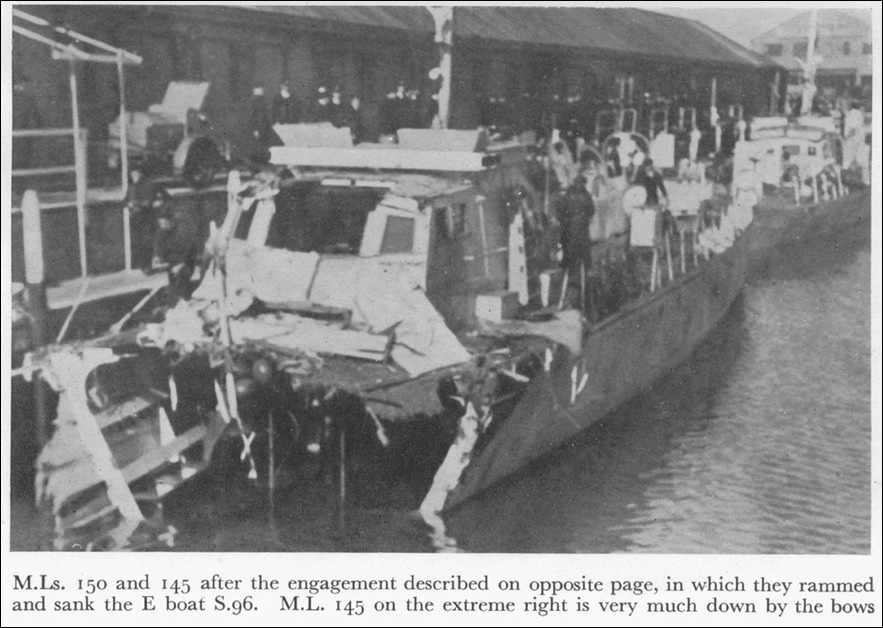
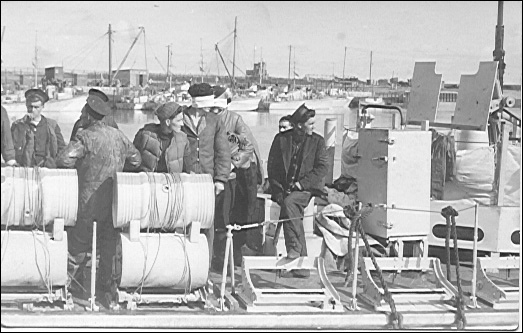
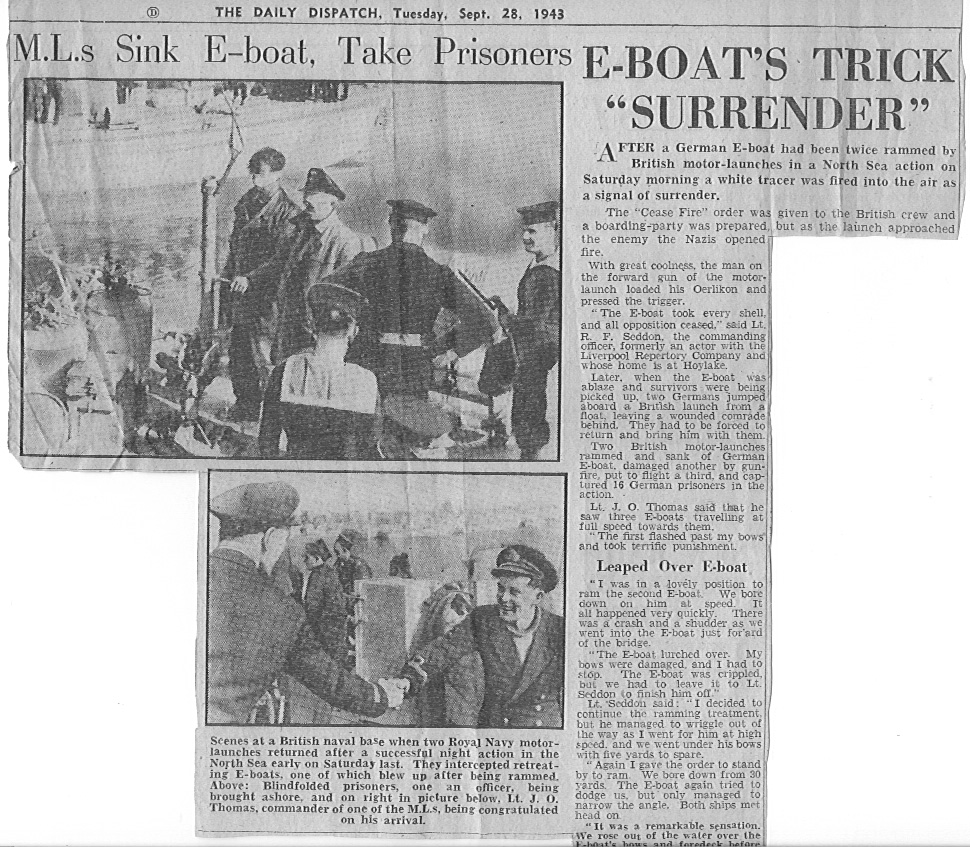
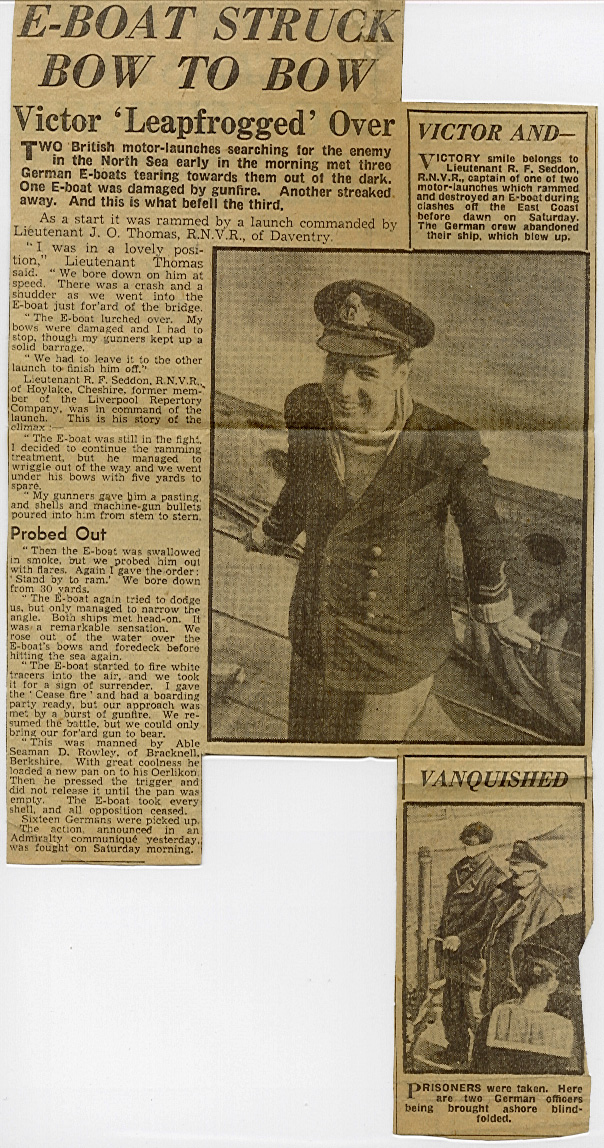
Rescued German prisoners are landed
Rescued German seamen
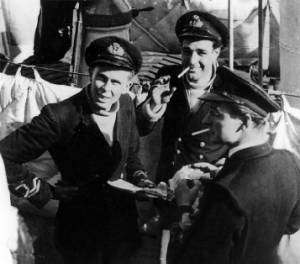
All rights reserved
| Photos |
| Dartmouth |
| Plouha |
| Norway |
| Ramming action |
| Photos ML145 |